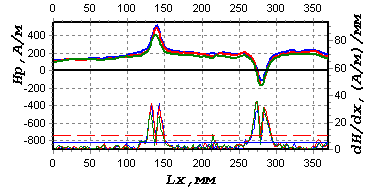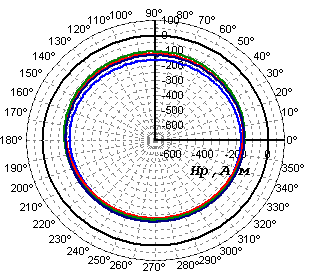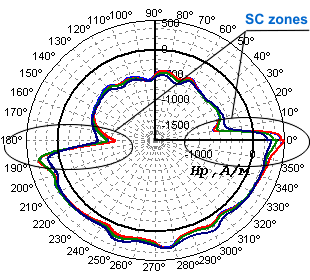Diagnostics of generator rotors and end-winding retaining rings
Diagnostics of rotors’ metal
Rotor shafts of power generators at thermal and nuclear power plants operate
in complex stressed conditions under cyclic loads. So upon the long-term
operation there is a possibility of their damaging with severe consequences due
to the metal fatigue. However until recently (as of January 2008) no
recommendations and techniques for inspection of the generator shafts metal
existed in the TPS and NPS.
Energodiagnostika Co. Ltd. has the experience in application of the metal
magnetic memory (MMM) method during the metal’s state inspection of PT-60,
T-100, K-200 and K-300 turbine generator shafts. As the experience of the rotors
inspection shows, the shaft necks are the most susceptible to damaging
zones.
Fig.1 shows the distribution of the Hp magnetic field, recorded during the inspection
along the shaft neck under the bearing # 7 of the K-200 generator at Zainskaya
TPS.

Fig.1. The distribution of the Hp magnetic field, recorded during the inspection along the
shaft neck under the bearing.
The zones of the abrupt local variation of the Hp field and its gradient dHp/dx correspond to stress concentration
zones. If the damaged metal layer is not timely removed in the stress
concentration zones by ordinary grinding during the repairs, the intensive
development of fatigue cracks is possible in these zones.
Diagnostics of generator end-winding retaining rings
In the course of turbogenerators operation defects occur on the end-winding
retaining rings, which, if not timely removed, tend to develop and may cause
serious accidents. At present the major measure to ensure reliability of the
end-winding retaining rings consists in marginal inspection by the
non-destructive methods and examination of the internal surface after their
removal from the rotor.
Energodiagnostika Co. Ltd. has the technique for inspection of the
end-winding retaining rings’ state without their removal from the generator
shaft. Besides, the technique allows carrying out the assessment of the
end-winding retaining rings fit tightness after their shrink fit during the
repairs.
Fig.2 shows the inspection results of an end-winding retaining ring located
on the side of the K-200 generator rotor half coupling.
 |
 |
Fig.2a. The results of an
end-winding retaining ring inspection in the section remote from the
fitting place. |
Fig.2b. The results of an
end-winding retaining ring inspection in the section coinciding with the
place of its shrink fit on the rotor. |
The inspection results, shown in fig.2, a, characterize the
satisfactory state of the end-winding retaining ring in the section 2, being
remote from the fitting place. Fig.2, b shows the magnetogram recorded
on the same end-winding retaining ring in the section, coinciding with the place
of its shrink fit on the rotor. The abrupt local variations of the Hp field correspond to the stress
and strain concentration zones. The damages develop exactly in these zones on
the internal surface of the end-winding retaining rings. |